 On a casual drive through the back roads of New England in the fall, the gradual change of the trees from green to brown heralds a time of a return to a cold and almost barren time of year. Then the leaves emerge in the spring and the forest once returns to a glorious verdant blanket.
On a casual drive through the back roads of New England in the fall, the gradual change of the trees from green to brown heralds a time of a return to a cold and almost barren time of year. Then the leaves emerge in the spring and the forest once returns to a glorious verdant blanket.
This cycle hints at the long, slow transformation of the world from hibernation to visible habitation. As humanity renews its interest in Mars, a new game delivers much the same experience on a distant planet. This game shows the kind of future we might see if independent companies lead the charge to colonize the red planet.
Terraforming Mars is a tableau-building, resource management game for 1-5 players that takes about 120 minutes to play. Terraforming Mars plays best with three players.
Game Overview:
Each player controls a corporation interested in transforming Mars so that large numbers of humans can thrive in residence. As the environment changes, players win by accumulating accolades for doing the most to bring new life to the planet. The end of the game arrives when the temperature, oxygen and presence of water are sufficient enough for more permanent settlement.
Game Components:
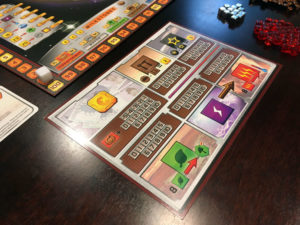
The main deliverables out of the box are cards, boards, hexagon tiles and plastic cubes. The cards are serviceable and seem to hold up to repeated play, but they do feel thin. The hexagon tiles and main board are sturdy cardboard. There are two kinds of plastic cubes, painted and translucent. The translucent cubes are nice if unremarkable, but the paint on the metallic cubes, while shiny, does seem to come off at the corners leaving flecks of paint on the table. This leaves some wonder if the paint will come off completely in the future. The game also comes with player mats which are of thin cardboard and seem like a downgraded component choice.
The main noticeable issue with the components is the art. While the main board and many of the cards present photorealistic depictions of different environmental and space projects, the art feels shallow somewhat, as if style was not important and just having a picture was.
The main board and player mat graphic design are one step from final polish. The graphic design is clear in purpose once explained, but color choice and a holistic approach to the main board and player mat design is lacking. However, the content of the cards and boards is very clear. A nice addition was having the full explanation in text of what the iconography on cards means.
How to Play:
Completing this gamified conversion of Mars first involves setting up the three main game timers and sources of terraforming. Tracking markers are placed on a Temperature Track and an Oxygen Track. These indicate the overall temperature and oxygen levels on the planet respectively. Nine water tiles are also placed in a stack on the board waiting to be placed on the planet. When each of the tracks reaches their end and all the water tiles are placed, the game ends.
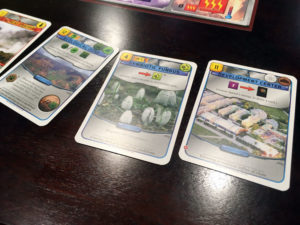
Players aim to do this by completing projects on the planet. A large stack of Project cards present different development projects that affect the planet and player resources. Some cards may directly raise the temperature or oxygen level. Some cards may require payment of certain resources (nearly all of them require money to be spent). Besides the cards, other projects are available on the game board. These involve additional standard actions such as creating forests, raising the temperature, founding a city, and so on.
Players may also fund other achievements yielding victory points at the end of the game. These come in the form of milestones and awards. If a player has already completed certain objectives (such as three cities founded) they may fund a milestone.
Awards work differently. A player may fund an award for “most of something”, but the recipient of the award is not known until the end of the game. During play, a player may make an assumption that they will be able to win an award, but other players may also compete to beat them to it.
The choices outlined above form the range of options for players on game turns. Each turn, a player may take one or two actions or pass. Once all players pass, the game round (a “generation” in game terms) ends. The option for one or two actions each turn allows players to control the pace of the game. For example, a project card may require that the planet’s temperature to reach a certain point before the card may be played. Some players may want to take two turns a round with actions to raise the temperature.
Each round, players will also receive production of their resources, as well as new project cards into their hands. Choosing the right project cards to keep (players must pay for each one they keep) and which ones to discard is at the heart of much of the strategy. As players collect and play project cards, they are focusing their corporation’s area of expertise, hopefully terraforming the planet in a way that earns the most points. Many of the project cards also provide a means to gain points at the end of the game, such as for increasing power production or encouraging life on the planet.
The game ends at the end of a round where nine water tiles have been placed and the oxygen and temperature tracks have reached their end. Points are totaled for awards, milestones, tiles placed and a player’s overall rating for terraforming the planet.
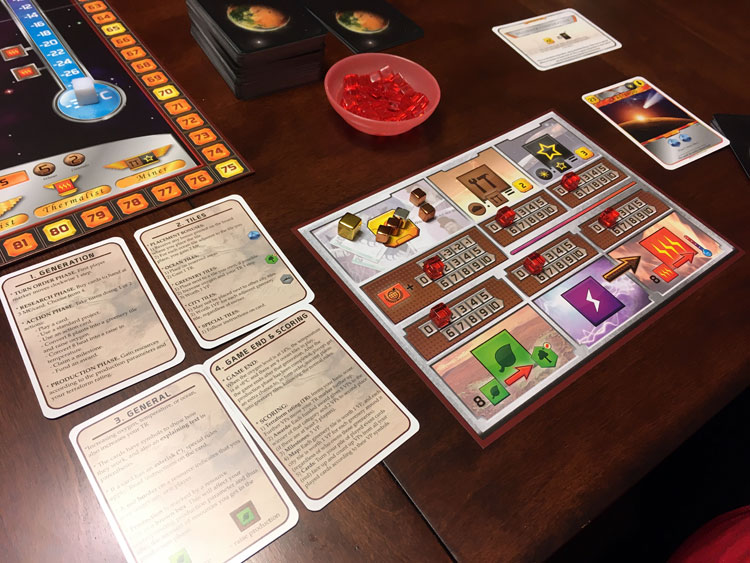
Game Experience:
Before stepping into criticism, it should be made abundantly clear that Terraforming Mars does a lot of things right. The main overall effect of this dichotomy is a sense that players can really like the game and ignore its faults or they may really dislike the game because of them, despite what it does well. The theme as the main hook is where these two diverging opinions hinge, and, either you’re in love with exploring the concept, or the educational curve takes its toll before you reach a second game.
The theme in Terraforming Mars is overwhelmingly well done. The intricacies of raising the planet’s temperature, oxygen, water sources and habitation is well-researched and tremendously deep. A first look at many of the cards is an exercise in understanding the nature of the science behind what the card represents and then applying the game mechanisms to a hopeful strategy.
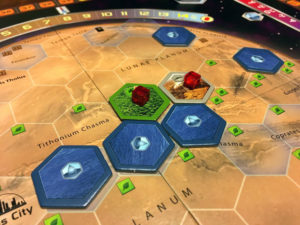
Without this integration of theme and mechanisms, the game would be abundantly boring. The simple fact that there are so many unique cards and they all represent different scientific projects (some more viable than others) with a relation to transforming a planet is astounding and beautiful. There are few other games that present this integration as beautifully as is done here.
The heavy theme comes with a price. There is a lot to comprehend when playing a first game. This is not to say that the rules are difficult to understand. On paper, they are simple. The mechanisms present no challenge. However, the game is obtuse and defies visible strategy until a player has digested a fair number of project cards and what they do. For someone who owns the game, this is tedious but necessary in order to teach the game. For someone sitting down to play for the first time, it becomes near-overwhelming because there are a tremendous number of decisions to make from the very first turn of the game.
Choosing the right project cards to pursue feels constraining and incomprehensible since it’s difficult to know what goals to aim for and the cards are expensive enough that you must choose some over others. The result of this is that players with even one game under their belts have an enormous advantage over new players, to the point that a win is practically assured. Combine it with the lack of any catch-up mechanism and the experience strongly discourages certain players to the point of ending the game with frustration.
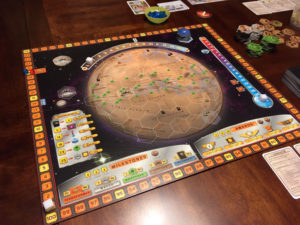
However, when players push past that and come to a second or third game, the nuance of some of the mechanisms gives even further pause. The standard rules require that each player be dealt four cards from the project stack. This deck represents cards of all layers of difficulty. Some can be played early in the game and some are better to be played late-game. There’s no separation and so parsing the cards and intentionally holding on to some is part of the strategy.
However, this slows down the game because money must be spent to acquire these cards. Additionally, through sheer random draw, a player may never see cards that augment a chosen strategy, thus causing the player to make a decision to shift to something else. However, some players by chance may get the perfect cards. This randomness makes the game feel arbitrary and a lack of separation of cards to different types to mitigate the randomness causes a feeling of under-developed game mechanisms.
A solution is presented in the rulebook with a drafting variant, and it partially solves the problem. Unfortunately, even with drafted cards, an opponent can discard options another player may need want thus increasing the broad but shallow range of a corporation’s projects.
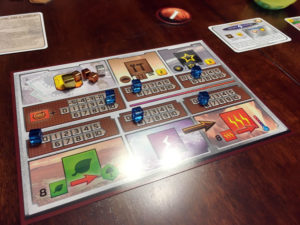
This criticism also leads to an exceptional part of the game. Building up a huge tableau of cards with combos is fun. Hunting and finding just the right card is almost like solving a jigsaw puzzle. Because of the low interaction with other players, the research and action phases where cards are selected and implemented feels like civilization building. Cards make combos with each other and a grand empire of corporate projects slowly appears before players. Grand moves are rare, but finding just the right sequence of cards to play drives engagement and satisfaction for the completion of a plan. It’s just disappointing that this activity is hampered by an inability to control it through strategy beyond selecting cards from a random set.
It is hard to evaluate games that are extremely enjoyable for a certain subset of gamers. Terraforming Mars presents just that. There are frequent moments of joy and challenge in the game, but also aggravation or hopelessness if playing for the first time with experienced players. In order to join that club of those who can sit down and compete, a player must go through a sort of hazing ritual by losing a first game. The best recommendation is a series of two player games (or solo game if possible) to quickly get through the understanding of the game to the point of enjoying the game.
Final Thoughts:
Science often presents concepts to humankind that challenge assumptions of the universe. There may be new ideas that must be learned before further knowledge can be acquired. This takes time. It is a central theme of human progress that knowledge builds upon what has come before. This is true of Terraforming Mars as well. To know whether you will like it requires one perfunctory play to understand the content and strategies. There is no way to teach the vast array of cards beforehand.
This will cause some consternation with certain players. New players may feel that they are not actually playing a game but making automated choices simply by what they are presented. This feeling passes and either eagerness for a repeated challenge or contentment with leaving the game on the shelf will result. Players should really be informed what a first play will entail before committing the time. Add to this the extended play time necessitated by the drafting variant and an unfriendly playtime with five players. This results in Terraforming Mars being a game that can generate very split opinions.
Terraforming Mars is not for everyone, but the weaknesses it presents can be mitigated. Unfortunately, the mitigations narrow the opportunities for play. This will either be perfect for a group’s play style or it will keep the game a runner-up choice for a game evening’s play.
If you’d like to pick up a copy of Terraforming Mars, you can get it for about $50.
Final Score: 3.5 Stars – Solid fun, but requires variants to minimize luck and experience from players to be strategic. New players should ideally play with other new players to not feel left out.
 Hits
Hits
• Experience required to be competitive
• Theme integrated deeply
• Good choices enhanced further with variant play
Misses:
• First play inexperience is noticeably punishing
• Low player interaction
• No catch-up mechanism







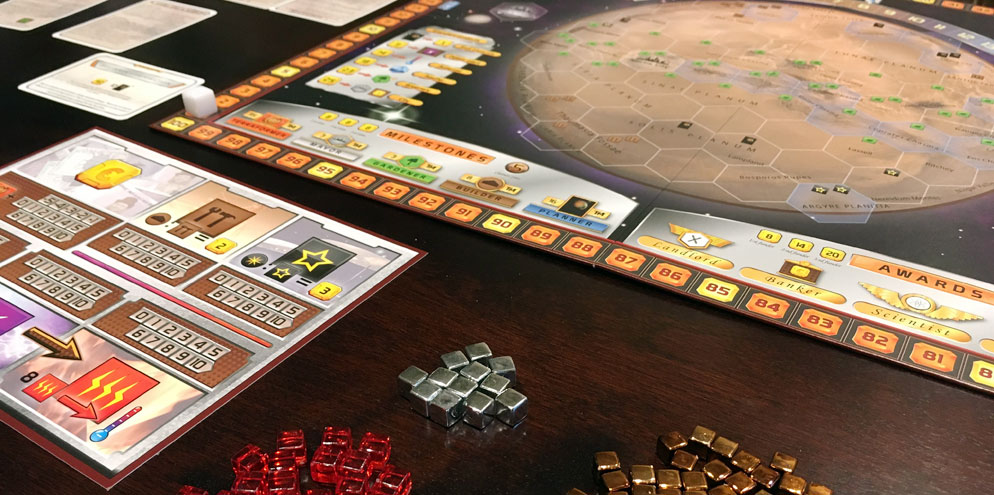















I feel kinda proud that my very recent review and thoughts on this game are pretty much the same as yours 🙂
The two “negative” points on No Catch up and Punishing noob aren’t that bad. Seriously. Experienced players should win more often, otherwise it is just luck based.
I’m not suggesting that experienced players shouldn’t win more often, just that with a first play and not being able to predict any of the abilities of the cards in a long game is not that enjoyable. It’s not just about winning, it’s about feeling that you can assimilate all the game mechanisms. With more than one new player and from my own experience, the game has no means to mitigate these things.
It’s easy to assimilate the game’s mechanics on the first play thru. The difficulty is learning the 208 different cards (base game only), and not knowing there’s cards in there that pull off huge combos. It simply comes down to the drafting phase – experienced players know what to keep, new players don’t.